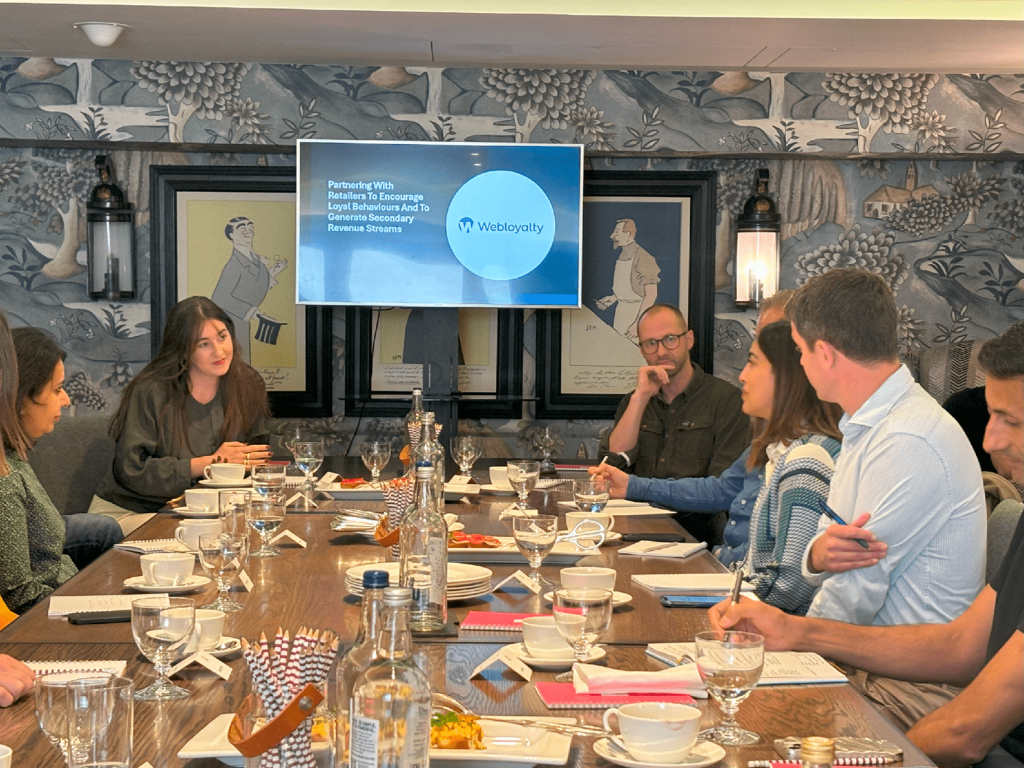From trialing and developing retail media and marketplace models, to unveiling additional services related to their core propositions and launching new product categories – digital commerce leaders are finding new ways to drive revenue.
Fundamentally, digital leaders in retail and those operating in adjacent sectors such as travel and hospitality are increasingly on the hunt for new revenue streams because it has become more difficult to drive growth from their core business areas.
These were all key themes as Retail Gazette and Webloyalty brought together senior representatives from retail, hospitality, and travel for an in-depth conversation over breakfast at London’s Haymarket Hotel. Attendees from Deliveroo, EE, Eurostar, John Lewis, JustEat, Merlin Entertainments, Microsoft, Selfridges, Tesco, and The Rug Company gathered for an illuminating debate that generated food for thought for everyone involved.
Below, we’ve highlighted five key talking points which neatly summarises the digital commerce landscape and the tactics involved for driving greater revenue. Quotes are anonymised reflecting the Chatham House Rules applied to the event discussion.
1. Flat core revenue so something new is needed

Although retailers in the room described varying levels of success in 2024, there was certainly a common feeling expressed that it’s currently a tough economic environment in which to operate. For that reason, new ideas and routes to making money are increasingly being explored.
One attendee said: “Competition is so intense at the moment and publically-listed businesses have the added pressure of needing to show continual growth. For that reason, many of us need to continue to innovate just to stay ahead.” Another guest noted that standing still is digital commerce – and business in general – is dangerous. “What consumers want from brands and businesses is certainly ever-evolving,” they explained. Often it could be a case of if you simply stick to what you’ve always done, you’ll be screwed!”
For many businesses, especially in retail, it is not necessarily a case of reinventing the wheel. Incremental value-add change can be a real winning tactic, the delegates agreed.
“You still need to be focused on the core, but it’s important to continue innovating and building new elements on top, such as offering an array of complimentary services or different in-store experiences that can enhance the perception of a brand in the eyes of consumers,” said one retailer.
2. Retail media and online marketplaces

As digital commerce has matured in recent years and companies operating in the space have built up vast data pools and heavy levels of traffic, there’s been a shift in thinking. Businesses are asking: how do we sweat these assets? How can we monetise this data? How can we drive more revenue without incurring significant additional investment costs?
It’s resulted in a plethora of retailers launching their own marketplaces which allow them to increase product range without necessarily taking on additional logistical and fulfilment burden. It’s worked to good effect at the likes of Decathlon and B&Q, while in the same week the roundtable took place, Tesco launched its own marketplace.
“Marketplaces work because they increase convenience for consumers,” argued one roundtable guest. “In this day and age, a customer will only complete their purchase at the checkout if it’s worth their while. They are discerning, and they are looking for convenience – and marketplaces often offer the right level of choice and service.”
Richard Piper, Business Development Director at Webloyalty, who took part in the roundtable, noted: “For the retailers that have successfully launched online marketplaces of their own, consumers will hardly notice the difference between the new model and their traditional offering. It’s important for retailers considering these platforms as new revenue streams to ensure they do not come across as separate entities to the core proposition.”
The largest grocers in the UK, as well as other sector leaders, are also exploring how to make retail media work. Essentially, they are becoming publishers and finding new ways to sell ad space to brands either online or in stores. “Retail media is a growing part of our overall operations, while core revenue is flat,” said one roundtable guest. “So you have to double down on these growth areas. I think that’s one reason why you’re seeing retail media grow more widely across the digital commerce ecosystem.”
3. Keep customers in view at all times

The delegates acknowledged listening to customer reaction is crucial in terms of understanding which new revenue streams are most likely to work. For specialist retailers, such as Hobbycraft or Space NK – for example – running specialist events, as they do, makes sense in terms of building out their communities. But businesses going too heavy into retail media could disrupt the consumer experience, or outsourcing delivery and customer service to third-party marketplace partners might mean retailers lose control over customer relationships.
“Think of the customer to begin with in any new venture – and that means getting the right data in the right place,” warned one guest.
“The key to anything in retail is listening to the customer at all times,” another retailer added.
Any new endeavours – be it retail media or otherwise – really need to be relevant to the existing brand, explained another delegate.
4. The disrupted become the disruptors
Several of those sitting around the table had found themselves disrupted by new players in the market, and there was a sentiment it was now their turn to cause the disruption.

“So much competition has emerged in digital commerce – be it travel, retail, or other sectors – in the last few years,” they admitted. “Some of these new players with what seemed like crazy ideas to begin with have simply wiped incumbents out of the market. Often you need to be the disruptor before you are disrupted out the market altogether.”
Internally, it can often be difficult to get sign-off at board level to be more disruptive and try new things. One retailer said: “Internal culture change is always a real difficulty when you want to try new approaches or explore fresh ways of driving revenue. As changemakers, you have to hold your nerve, and use emotion and intellect in getting your business case across to the board.”
5. Don’t overstretch yourself

Indeed, getting the finance boss bought in is “absolutely essential”, said one retailer. “There’s no use trying to get a new venture kickstarted with ‘stupid maths’. Often, framing a new revenue stream idea with a ‘cost of inaction’ sum can be more important than creating an overly-ambitious return-on-investment projection.”
And therein lies another warning – all of which was made clear during the breakfast discussions: retailers and brands looking to play outside their traditional lanes must be so careful not to overstretch themselves. It was also suggested that people on the shopfloor in retail and traditional sales staff need to be consulted by their employers when new ideas, experience-led services, or different business models are being devised.
One retailer commented: “When you’re moving into new areas, you have to understand what the right and most appropriate adjacencies are – it can be too much of a cultural shift and the long-terms can become a distraction to the core business.”
Dominic West, Managing Director for Webloyalty in Northern Europe, who took part in the roundtable discussion, said: “Organisations tapping into new areas to drive additional revenues is such an exciting part of the modern digital landscape. “Advertising, subscription schemes, financial services, marketplaces, events, and expanding into new categories are all examples of how retailers, brands, and commerce companies are expanding their repertoire. There are so many different models forming for engaging consumers but what is common is that organisations in this space are hungry to drive new revenue and simply need to do it to support their growth.”
He added: “There is no doubt retailers are increasingly leveraging their customer data to determine which additional revenue streams should receive their time and attention, and those doing this well will ultimately be the most likely to see the greatest returns.”
Discover more about how businesses are choosing to diversify their revenue streams here.